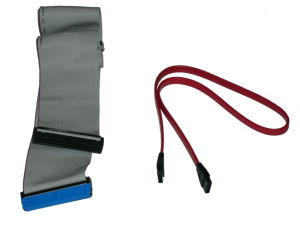151. Moving to a New Hard Drive
By Andrew D. Wright
Moving to a new hard drive is a lot like moving to a new house. It may be
bigger, better and have faster freeway access but there is still some
housekeeping to be done.

There are two kinds of new hard drive for sale, IDE and SATA. The
connections for data and power to these drives are different and not
interchangeable. IDE (cable pictured on the left) is a dying format while
SATA (the cable on the right) is simpler to connect
and faster.
Motherboards made since 2005 should have a built-in SATA controller. Power
supplies of the same vintage should have SATA power connections but if not
adapters converting a standard four pin Molex power connection to the
L-shaped SATA power connection are cheap ($5-$10 depending where you go).
If there is no SATA controller, there are SATA controller cards available
which fit in a standard PCI slot so any computer can use SATA hard drives.
Since the SATA standard is in wide use, it means your new hard drive will
be easily transferable to new hardware in the future.
There are two main approaches to moving to a new hard drive, and both have
their merits.
The first approach is to use the move to the new hard drive as an excuse
for a fresh installation of the operating system. Technically this is the
better way to go as a fresh install will offer better performance and do
away with any unused drivers from old software, old registry entries and
other crud that might be hanging around slowing things up.
With this approach you need your operating system installation CD or DVD,
install CDs for your computer's hardware and the installation programs for
any software you want to run. Set the computer to boot from the operating
system installation CD and the rest of the process should be straight
forward. If installing an earlier operating system such as original
release Windows XP, you may need a floppy disk ready with the SATA
controller drivers on it. These can usually be found on the SATA
controller or the motherboard manufacturer's website.
As soon as your operating system is up and running, download and install
its security updates right away before installing any other software.
Next, update any critical system drivers such as video and audio devices
to the current versions. Then install your existing software such as email
programs, printing software, etc. and check their websites for updates.
The second approach to moving to a new hard drive is to clone the current
hard drive. While this does not offer the same spring-clean fresh computer
system, it does save a lot of time on updates and everything looks the
same as it did running on the old hard drive.
Trying to do a straight copy using Windows will not work as files in use
cannot be copied. One way to get around that is to use a partition copying
program.
Data on your hard drive is organized by partitions. Think of the hard
drive as an apartment building. The partitions would be the walls
separating the different tenants from each other. Maybe there is one big
apartment, maybe there are two or more smaller ones.
EASEUS offers a free program called Disk Copy that allows you to clone
your present hard drive and resize the partition to the size of the new
drive. Burn the ISO file to a blank CD then boot from it with the new and
old drives connected. EASEUS also offers a fuller-featured commercial
program called Partition Master with more options for managing partitions.
EASEUS Disk Copy (free):
http://www.easeus.com/disk-copy/
The Mousepad runs every two weeks. It's a service of Chebucto Community
Net, a community-owned Internet provider. If you have a question about
computing, email mousepad@chebucto.ns.ca or
click here. If we use your question
in a column, we'll send you a free mousepad.
Originally published 30 April 2009